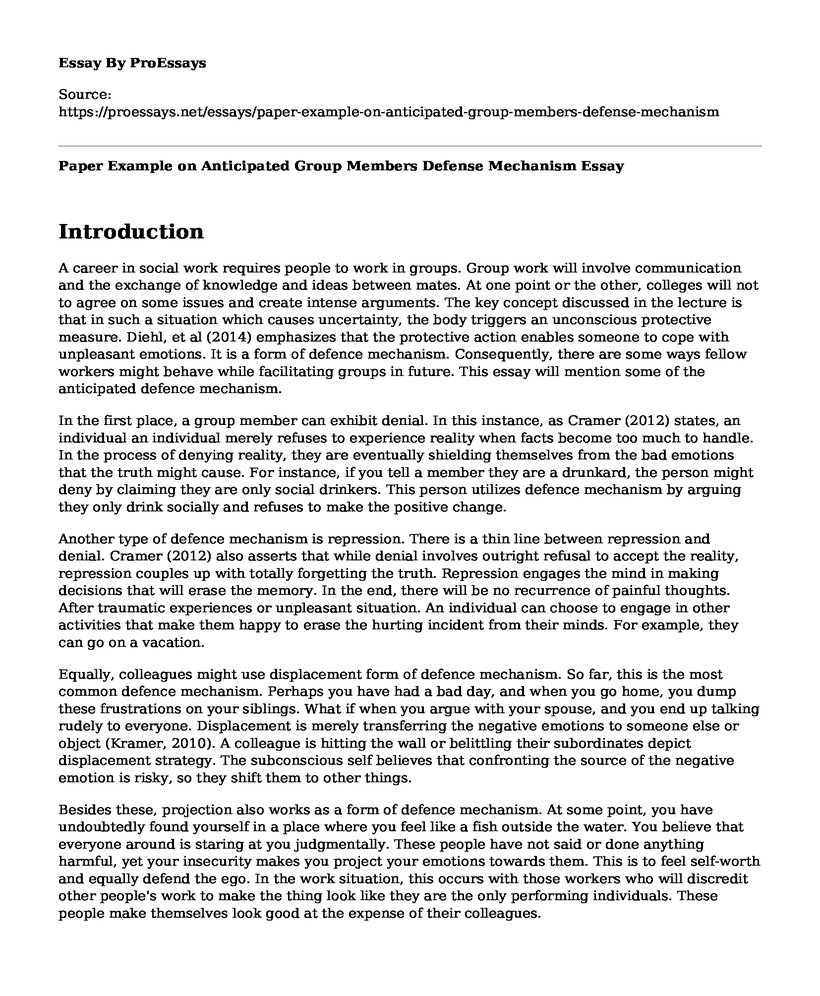Introduction
A career in social work requires people to work in groups. Group work will involve communication and the exchange of knowledge and ideas between mates. At one point or the other, colleges will not to agree on some issues and create intense arguments. The key concept discussed in the lecture is that in such a situation which causes uncertainty, the body triggers an unconscious protective measure. Diehl, et al (2014) emphasizes that the protective action enables someone to cope with unpleasant emotions. It is a form of defence mechanism. Consequently, there are some ways fellow workers might behave while facilitating groups in future. This essay will mention some of the anticipated defence mechanism.
In the first place, a group member can exhibit denial. In this instance, as Cramer (2012) states, an individual an individual merely refuses to experience reality when facts become too much to handle. In the process of denying reality, they are eventually shielding themselves from the bad emotions that the truth might cause. For instance, if you tell a member they are a drunkard, the person might deny by claiming they are only social drinkers. This person utilizes defence mechanism by arguing they only drink socially and refuses to make the positive change.
Another type of defence mechanism is repression. There is a thin line between repression and denial. Cramer (2012) also asserts that while denial involves outright refusal to accept the reality, repression couples up with totally forgetting the truth. Repression engages the mind in making decisions that will erase the memory. In the end, there will be no recurrence of painful thoughts. After traumatic experiences or unpleasant situation. An individual can choose to engage in other activities that make them happy to erase the hurting incident from their minds. For example, they can go on a vacation.
Equally, colleagues might use displacement form of defence mechanism. So far, this is the most common defence mechanism. Perhaps you have had a bad day, and when you go home, you dump these frustrations on your siblings. What if when you argue with your spouse, and you end up talking rudely to everyone. Displacement is merely transferring the negative emotions to someone else or object (Kramer, 2010). A colleague is hitting the wall or belittling their subordinates depict displacement strategy. The subconscious self believes that confronting the source of the negative emotion is risky, so they shift them to other things.
Besides these, projection also works as a form of defence mechanism. At some point, you have undoubtedly found yourself in a place where you feel like a fish outside the water. You believe that everyone around is staring at you judgmentally. These people have not said or done anything harmful, yet your insecurity makes you project your emotions towards them. This is to feel self-worth and equally defend the ego. In the work situation, this occurs with those workers who will discredit other people's work to make the thing look like they are the only performing individuals. These people make themselves look good at the expense of their colleagues.
Conclusion
To sum up, the body will subconsciously defend itself from negative emotions. The body uses several forms of defence in each situation. The ones mentioned above are just but a few. In future, it is crucial to understand colleagues in times of argument as the lecture suggested.
References
Cramer, P. (2012). The development of defense mechanisms: Theory, research, and assessment. Springer Science & Business Media.
Diehl, M., Chui, H., Hay, E. L., Lumley, M. A., Gruhn, D., & Labouvie-Vief, G. (2014). Change in coping and defense mechanisms across adulthood: Longitudinal findings in a European American sample. Developmental Psychology, 50(2), 634.
Kramer, U. (2010). Coping and defence mechanisms: What's the difference?-Second act. Psychology and psychotherapy: theory, research and practice, 83(2), 207-221.
Cite this page
Paper Example on Anticipated Group Members Defense Mechanism. (2022, May 16). Retrieved from https://proessays.net/essays/paper-example-on-anticipated-group-members-defense-mechanism
If you are the original author of this essay and no longer wish to have it published on the ProEssays website, please click below to request its removal:
- The Bridge Between Childhood and Adulthood - Essay Sample
- Essay on Unconditional Love Beyond Blood Ties: A Story of My Life
- Paper Example on My Nature Escapades: Exploring Waterfalls for Stress Relief
- Essay on Counselors Helping Battered Women to Overcome Career Challenges
- Essay Example on Schizophrenia Assessment: Delusion, Hallucination & More
- Essay Sample on Understanding Socio-Cultural Theories: Impact on Human Behavior & Learning
- Paper on Analyzing the Termination Decision: Workplace Misconduct at William Beaumont Hospital







